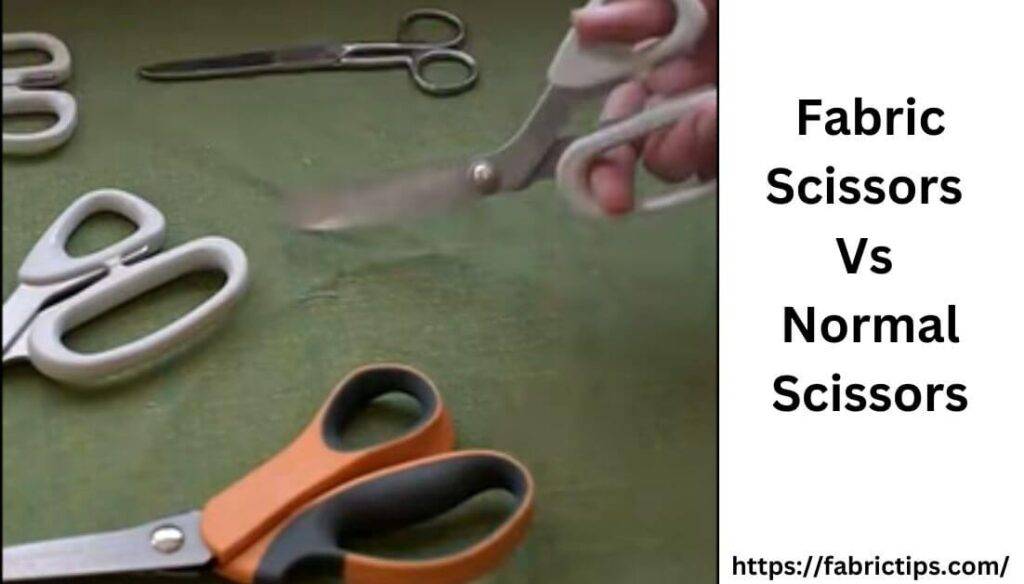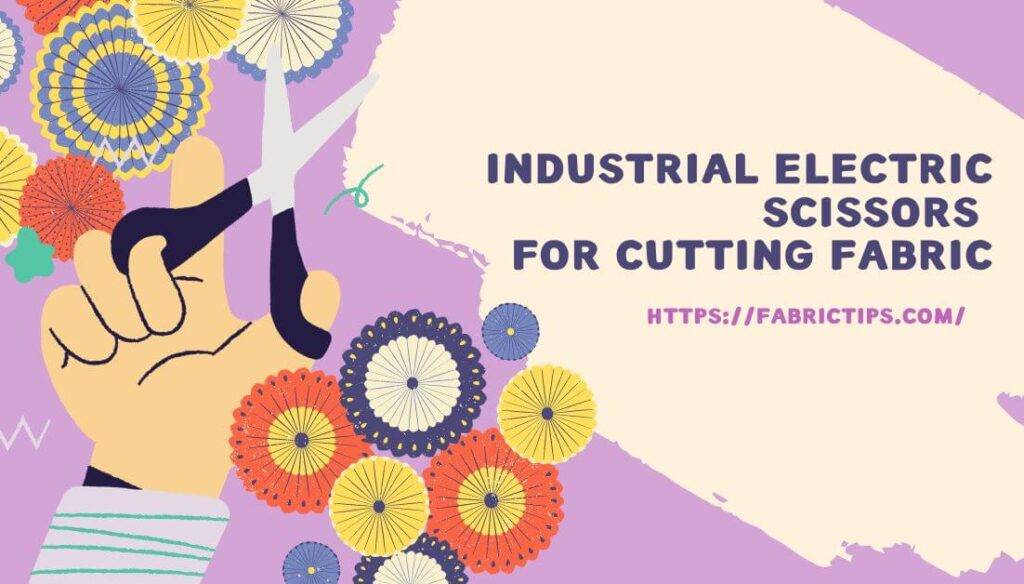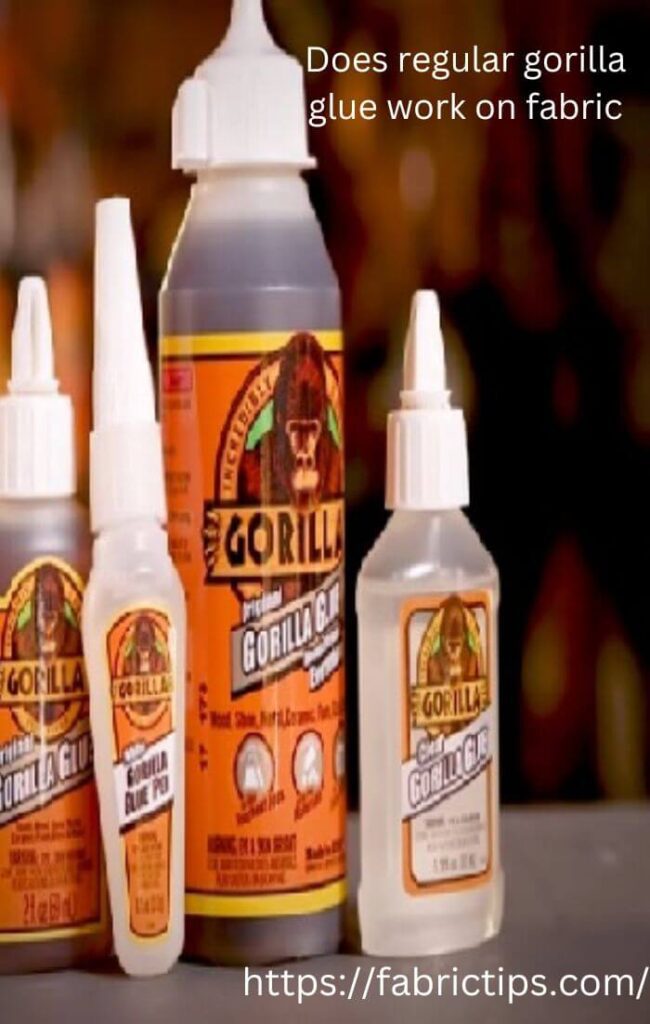Last Updated on January 27, 2024 by Wahid
When you first start sewing, you might wonder how fabric scissors differ from regular scissors. Fabric scissors are necessary? Are normal scissors able to cut fabric?
Fabric Scissors Vs Normal Scissors: what is the winner and better? Normal scissors blade is blunter and thinner than a fabric scissors blade. Hence, fabric scissors have sharper blades and steeper cutting angles. Ordinary scissors are usually made of stainless steel, while fabric scissors are usually made of carbon steel, which lasts longer & sharpens better.
Generally, the size of normal scissors is smaller. They have shorter blades and smaller handles (called ‘bows’). Anyway, fabric scissors are long, allowing for lengthy and smooth cuts. There is also a larger & more comfortable handle.
Throughout this post, I’ll let scissors professionals explain in-depth detail the differences and similarities between Fabric Scissors and Normal Scissors. Well, without further delay, let’s continue below for more valuable information.
Fabric Scissors Vs Normal Scissors: Brief Comparison Table
Fabric scissors are specifically designed to cut fabric and related materials without damaging the fibers. Frayed edges or uneven cuts may result from using normal scissors on fabric. In contrast, normal scissors can be used for a wide variety of cutting tasks around the house, office, and classroom. An overview of fabric scissors compared to normal scissors is shown below:
| Feature | Fabric Scissors | Normal Scissors |
| Blade Type: | Long, sharp, & pointed blades | Round-tipped blades that are shorter |
| Blade Material: | High-quality titanium or stainless steel | Stainless steel, carbon steel, or other alloys |
| Blade Sharpness: | Extremely sharp for fast & accurate cutting | Sharp, but not quite as sharp as fabric scissors |
| Handle Design: | Designed ergonomically for comfortable gripping | Designs & materials of handles vary |
| Cutting Capacity: | Cuts through a range of fabrics easily | Suitable for most cutting tasks |
| Application: | Ideal for cutting fabric, thread, and yarn | Suitable for paper, cardboard, and light-duty materials |
| Scissor Size: | Long and short versions are available | Different lengths are available |
| Price Range: | Quality usually makes it more expensive | Cost-effective in general |
| Maintenance: | Occasionally require sharpening & lubrication | Less maintenance required |
However, in fabric or sewing projects, fabric scissors can make or break your cut quality and the final outcome. Check out Fiskars Pointed-Tip Kids Scissors for cutting through every kind of classroom materials; it’s Ideal for 4 to 7 ages kids; #1 brand recommended by teachers.
Fabric Scissors Vs Normal Scissors: Differences

Both fabric scissors and normal scissors have different characteristics, such as the design of their blades, their materials, their sharpness, and their intended purposes. I will explain the differences in more detail below:
Blade Design
Fabric scissors have long, sharp, and pointed blades that allow them to cut fabric, thread, and yarn precisely. Using the pointed tip allows you to make intricate cuts and navigate through tight spaces. In contrast, normal scissors typically have shorter blades and rounded tips that are better suited to cutting lightweight materials such as paper and cardboard.
Blade Material
Fabric scissors are usually made from stainless steel or titanium. Durability, sharpness retention, and corrosion resistance are all ensured by these materials. You can check out Gingher Dressmaker’s Fabric Scissors – 8″ Stainless Steel Shears for the best performance. Normal scissors are generally made from steel, carbon steel, or other alloys, depending on the use they are intended for.
Blade Sharpness
Fabric scissors are exceptionally sharp, so they can cut fabric cleanly and accurately without fraying or damaging the fibers. Despite extended use, they retain their sharpness. Although normal scissors are sharp, they may not be as precise and sharp as fabric scissors.
Handle Design
The handle design of fabric scissors is usually ergonomic, providing optimum hand comfort for prolonged cutting sessions. Cushioning or finger loops may enhance control & precision on the handle. Basically, handles and materials of normal scissors vary in terms of comfort & ergonomics.
Intended Applications
Fabric scissors are designed for cutting fabrics, threads, yarns, and other sewing materials. Due to their sharpness and pointed tip, they make clean cuts on fabrics without snagging them or pulling them. In contrast, normal scissors, useful in everyday life for cutting paper, opening packages, and trimming lightweight materials, are versatile tools. You must check this out Amazon Basics Multipurpose, Comfort Grip, PVD Coated multipurpose office scissors for cutting paper, cardboard, fabric, photos, and more.
Cutting Capacity
Fabric scissors are designed to cut fabrics of varying thicknesses and textures. Multiple layers of fabric can be cut smoothly and accurately with them. It may be difficult for normal scissors to cut through thick fabrics with the same level of precision as a set of sharp scissors.
Size & Variations
Both fabric scissors and normal scissors come in a variety of lengths to suit different cutting requirements. Typically, fabric scissors come in larger sizes for cutting large pieces of fabric, whereas normal scissors can come in smaller sizes for precision cutting.
Price Range
Fabric scissors are generally more expensive than regular scissors. Fabric cutting requires precision engineering, and their sharpness lasts for a long time, which normally accounts for the higher price.
Maintenance
To maintain cutting performance, fabric scissors need to be sharpened and lubricated on an occasional basis. It is recommended to use them exclusively for cutting fabric to prevent dulling. Generally, normal scissors require less maintenance and can be used for a wider range of tasks without having to be sharpened frequently.
When using fabric scissors on non-fabric materials, their blades are dulled, which makes them ineffective for cutting fabric. The best way to maintain the performance of fabric scissors is to reserve them solely for fabric-related projects.
Fabric Scissors Vs Normal Scissors: Similarities
Although fabric scissors and normal scissors have distinct differences, they also have some similarities. The following are some similarities between fabric scissors and normal scissors:
Cutting Mechanism
Both fabric scissors and normal scissors operate on a pivoting mechanism that opens and closes the blades. By using this mechanism, the user can control the cutting action with their hands.
Handles
During cutting, users can grip and control both types of scissors using their handles. Fabric scissors may have different handle designs than normal scissors, but they both provide comfortable grips and facilitate precise cutting.
Versatility
Although fabric scissors are primarily used to cut fabric and related materials, regular scissors can handle a wide range of cutting tasks. It is capable of cutting paper, cardboard, lightweight plastics, and other materials as well. Due to their versatility, Fiskars SoftGrip PowerCut Fabric and Mixed Media Scissors are suitable for use in households, offices, classrooms, and crafting projects without fabrics.
Size Variation
Both fabric scissors and normal scissors are available in a variety of sizes to meet the needs of different users. To accommodate different hand sizes and cutting preferences, they come in small, medium, and large sizes.
Cutting Efficiency
Both types of scissors are designed to cut efficiently. In contrast to fabric scissors, normal scissors are designed to deliver smooth cuts in materials such as paper or lightweight fabrics. You can buy Scotch 8″ Precision Scissors, Great for Everyday Use.
Household Tool
Fabric scissors and normal scissors both serve as essential cutting tools in households. You can use them to cut fabric for sewing projects or to open packages with normal scissors.
Maintenance
Fabric scissors and normal scissors both need maintenance to last a long time and perform well. Sharpening fabric scissors and lubricating them occasionally may maintain their cutting ability, similarly, normal scissors can be sharpened periodically to retain their cutting ability.
Actually, fabric scissors and normal scissors differ significantly, but in different situations both are indispensable. Hence, specific cutting requirements and general cutting tasks are catered to by them.
Fabric Scissors Vs Normal Scissors: Advantages and Disadvantages
Fabric scissors and normal scissors have the following advantages and disadvantages:
Fabric Scissors Advantages:
- Precise Cutting: Fabric scissors are designed specifically to cut fabric, thread, yarn, & other sewing materials. Clean and precise cuts are achieved without fraying or damaging the fabric.
- Sharpness Retention: High-quality fabric scissors are made with stainless steel or titanium, making them durable and sharp even after extended use.
- Ergonomic Design: Fabric scissors have ergonomic handles that provide a comfortable grip, reduce hand fatigue, and enhance control.
- Cutting Capacity: Fabric scissors have the ability to cut through multiple layers of fabric, which is ideal for sewing projects involving thick fabrics and complex cuts.
Fabric Scissors Disadvantages:
- Limited Application: Fabric scissors are primarily used to cut fabric. When cutting non-fabric materials or general-purpose tasks, they may not perform as well.
- Higher Cost: Fabric scissors typically cost more than normal scissors due to their high-quality materials, specialized design, and precision engineering.
- Maintenance Required: To maintain their cutting performance, fabric scissors need occasional sharpening & lubrication. In order to prevent dulling, they should only be used for cutting fabric.
Normal Scissors Advantages:
- Versatility: Normal scissors are versatile tools that can perform a variety of cutting tasks. Among the materials they can cut are paper, cardboard, lightweight plastics, and more.
- Affordability: Normal scissors are generally less expensive than fabric scissors, making them suitable for household, office, classroom, and crafting use.
- Availability: Normal scissors come in a wide range of sizes, shapes, and prices, offering a variety of options for specific applications.
Normal Scissors Disadvantages:
- Less Precision: While cutting fabrics or delicate materials, normal scissors may lack the precision of fabric scissors. Fabric may be frayed or cut unevenly as a result.
- Limited Cutting Capacity: Normal scissors may struggle to cut through thicker materials, for example, heavy fabrics or thick cardboard.
- Handle Comfort: Normal scissors have various handle designs, but some may not be as ergonomically comfortable as fabric scissors, resulting in possible hand fatigue.
Ultimately, fabric scissors and normal scissors are chosen depending on the specific materials and cutting needs. While fabric scissors excel at cutting fabric precisely, normal scissors are versatile for a variety of cutting tasks. To cater to different cutting needs, both types of scissors are beneficial.
Fabric Scissors Vs Normal Scissors: Who Offers Better Value & Winner?
Choosing fabric scissors over normal scissors depends on the particular task at hand. To decide which one is best suited for different uses, let’s compare their design, functionality, and value.
- Fabric scissors are large and designed specifically for cutting fabric. Fabric cutting blades are sharp, precision ground, and allow for clean cuts without fraying or damaging fibers. To prevent the fabric from slipping, fabric scissors have serrated or zigzag blades. In addition, they are often designed with longer handles for better control and leverage.
- In contrast, normal standard scissors are designed to handle a wide variety of cutting jobs. Typically, they are used to cut paper, cardboard, packaging materials, and lightweight materials. Despite their differences in size and design, normal scissors usually have straight blades and shorter handles.
- Choosing fabric scissors over normal scissors depends on your specific needs. Investing in a pair of fabric scissors is a good idea if you frequently work with fabrics. For fabric-related tasks, they will provide better value in terms of performance & longevity.
- However, normal scissors may be a better option if you want a versatile pair of scissors that can handle a variety of materials, including fabric. In general, they are more accessible and more affordable, making them a useful choice.
In the end, a winner is determined by the intended use. Invest in fabric scissors if fabric cutting is a significant part of your activities, although normal scissors should suffice when cutting fabric occasionally.
FAQs
01. Can you cut fabric with normal scissors?
Answer: When cutting fabric with typical normal scissors, you will struggle to make a clean cut. In comparison with fabric scissors, normal scissors have thinner blades that are shorter and blunter.
02. What can you not cut with fabric scissors?
Answer: Keep your fabric scissors away from anything but cutting fabric. Fabric scissors can be dulled quickly by cutting paper, plastic, or anything that is not fabric. Make sure you don’t hit pins when cutting. If you cut into a pin by accident, your scissors will be damaged.
03. Can you sharpen fabric scissors?
Answer: To sharpen your scissors, use fine-grained sandpaper between #180 and #220. Then fold the sandpaper in half, thus both sides being gritted, using all the blade edges of your blunt scissors to cut through the paper.
04. Why are fabric scissors so big?
Answer: For cutting large pieces of fabric, thick materials, or layers of fabric, a larger pair of scissors is useful. All fabric shears, tailor’s sidebent shears, and dressmaker’s shears have long, sharp blades. Use them only to cut fabric, not paper, to extend their lifespan.
05. Can fabric scissors cut jeans?
Answer: With fabric scissors, you can easily cut through denim and achieve clean lines. You can also use regular scissors instead of fabric scissors. It is just important that they are nice and sharp. With your chalk, you can draw a straight line using a ruler to get a perfect cut.
06. What kind of scissors is used for cutting cloth?
Answer: A dressmaker’s shears have a long blade, making them perfect for cutting fabric. They have tapered blades with one rounded tip and one pointed tip; their blunt tips help protect the fabric from getting snagged on threads and seams.
One Last Thought
Fabric scissors and normal scissors are designed to serve different purposes and have their own advantages. Your specific requirements will determine whether to use fabric scissors or normal scissors. As an individual who regularly cuts fabric and desires clean, precise cuts without fraying, fabric scissors are a good investment. Alternatively, when you require scissors that can handle varied materials and are capable of a wide range of uses, normal scissors provide more versatility and are cost-effective as well.


